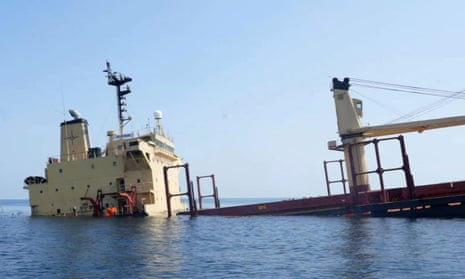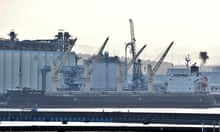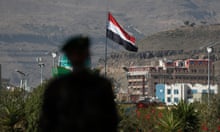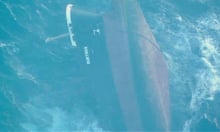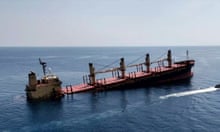A UK-owned ship attacked by Yemeni Houthis has sunk in the Red Sea after days of taking on water, the first vessel to be fully destroyed as part of the rebels’ campaign over Israel’s war against Hamas in Gaza.
The sinking of the Rubymar comes as shipping through the crucial waterway for cargo and energy shipments moving from Asia and the Middle East to Europe has been affected by the Houthi attacks.
Many ships have turned away from the route. The sinking of the Rubymar could lead to further detours and higher insurance rates put on vessels plying the waterway – potentially driving up global inflation and affecting aid shipments to the region.
The US military published an image of the sinking vessel and said it now posed a risk to the environment and shipping. “The approximately 21,000 metric tons of ammonium phosphate sulfate fertilizer that the vessel was carrying presents an environmental risk in the Red Sea. As the ship sinks it also presents a subsurface impact risk to other ships transiting the busy shipping lanes of the waterway,” it said on Sunday.
Sinking of Motor Vessel⁰Rubymar Risks Environmental⁰Damage
— U.S. Central Command (@CENTCOM) March 3, 2024
On Mar. 2 at approximately 2:15 a.m., MV Rubymar, a Belize-flagged, UK-owned bulk carrier, sank in the Red Sea after being struck by an Iranian-backed Houthi terrorist anti-ship ballistic missile on Feb. 18.
The ship… pic.twitter.com/fRUM4ll4cY
Ian Ralby, founder of maritime security firm IR Consilium, said part of the environmental dangers lay in the Red Sea’s circular water patterns. It operates essentially as a giant lagoon, with water moving northward, toward the Suez canal in Egypt, during winter and outward to the Gulf of Aden in summer.
“What spills in the Red Sea, stays in the Red Sea,” said Ralby. “There are many ways it can be harmed.”
The Belize-flagged, Lebanese-operated Rubymar had been drifting northward after being attacked on 18 February in the Bab el-Mandeb strait, a crucial waterway linking the Red Sea and the Gulf of Aden.
Yemen’s internationally recognised government, as well as a regional military official, confirmed the ship had sunk. The official spoke on condition of anonymity as no authorisation was given to speak to journalists about the incident.
The UK Maritime Trade Operations centre, which watches over Middle East waterways, separately acknowledged the Rubymar’s sinking on Saturday afternoon.
The Beirut-based manager of the Rubymar could not be immediately reached for comment.
Yemen’s exiled government, which has been backed by a Saudi-led coalition since 2015, said the Rubymar sank late on Friday in stormy weather over the Red Sea. The vessel had been abandoned for 12 days after the attack, although plans had been made to try to tow it to a safe port.
The Iran-backed Houthis, who claimed the ship sank almost immediately after the attack, did not acknowledge the ship’s sinking.
The US military’s Central Command had previously said the vessel’s cargo of fertiliser, as well as fuel leaking from the ship, could cause ecological damage to the Red Sea.
Ahmed Awad bin Mubarak, the new prime minister of Yemen’s government, called the ship’s sinking “an unprecedented environmental disaster”.
“It’s a new disaster for our country and our people,” he wrote on X. “Every day, we pay for the Houthi militia’s adventures, which were not stopped at plunging Yemen into the coup disaster and war.”
Since November, the rebels have repeatedly targeted ships in the Red Sea and surrounding waters in protest against Israeli attacks in Gaza. Those vessels have included at least one with cargo bound for Iran, the Houthis’ main benefactor, and an aid ship bound for Houthi-controlled territory.
Despite more than a month of US-led airstrikes, Houthi rebels remain capable of launching significant attacks. That includes the attack on the Rubymar and the downing of a US drone worth tens of millions of dollars.
The Houthis insist their attacks, which have enraged the wider Arab world, will continue until Israel stops its combat operations in Gaza.
However, in recent days, there has been a slowdown in attacks. The reason for that remains unclear.
